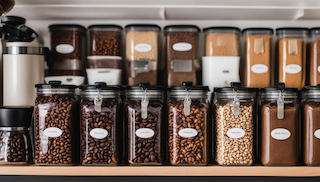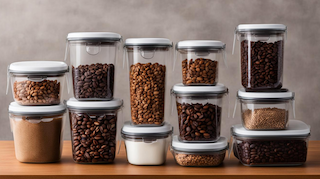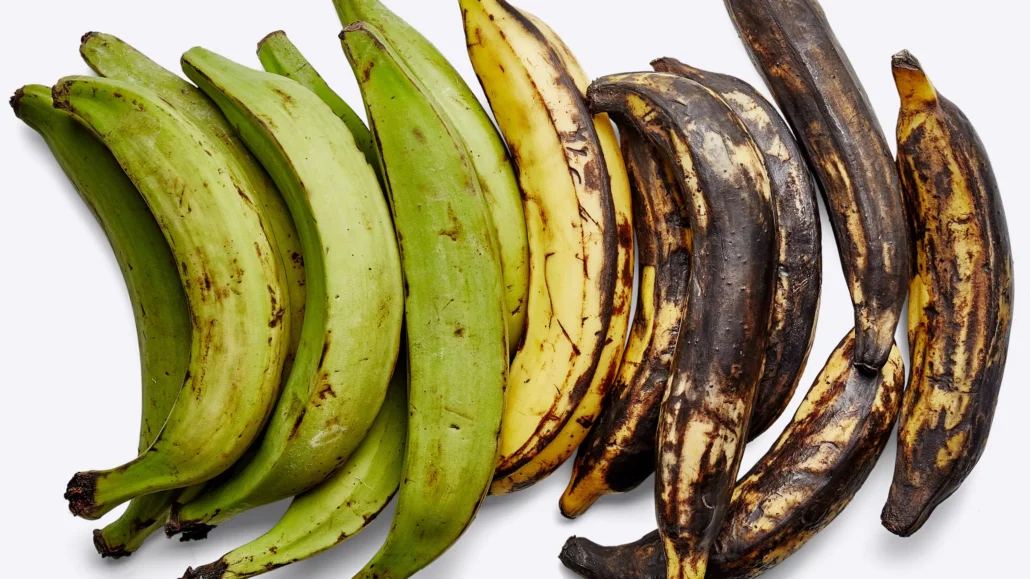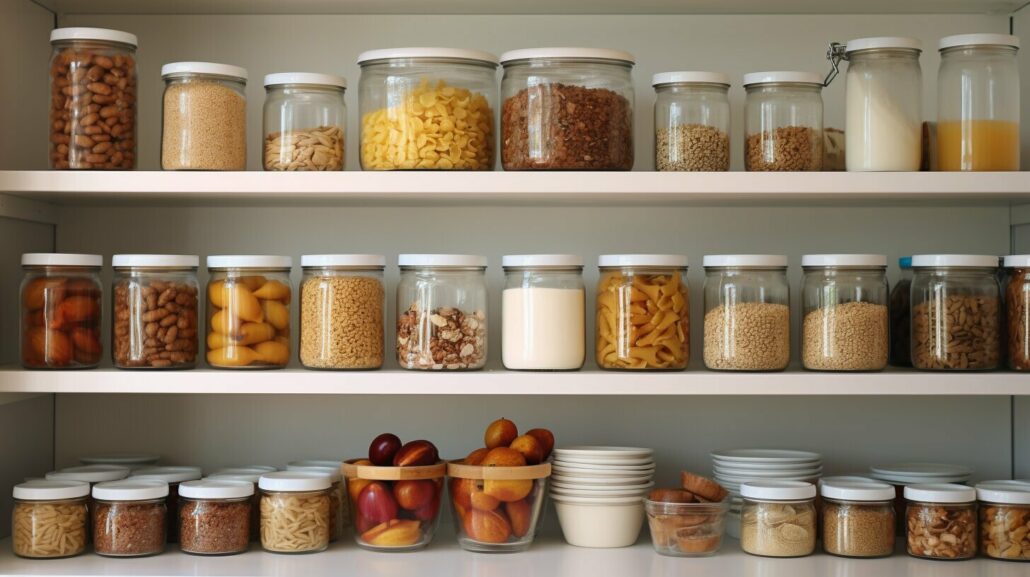If you’re a coffee enthusiast, you likely understand the importance of preserving the freshness of your beans to maintain their flavor and aroma. Proper storage is essential to protect coffee beans from air, moisture, light, and temperature fluctuations. In this guide, I’ll provide you with valuable coffee storage tips and dive deep into the various coffee preservation methods, helping you learn how to store coffee long term in the most effective ways possible.
Key Takeaways
- Freshly roasted coffee should be consumed within 7-10 days to ensure optimal flavor and aroma.
- Storing coffee effectively involves protecting it from air, moisture, light, and temperature fluctuations.
- Using airtight containers, vacuum sealing, and freezing are effective long-term storage methods.
- Pre-ground coffee has unique storage requirements due to its increased surface area exposed to air.
- Refrigerating coffee is a common myth and can lead to loss of flavor and aroma.
- Segmenting bulk coffee supplies into smaller amounts can help maintain freshness.
- The pantry can be a suitable storage location if ideal conditions are met.
The Fundamentals of Coffee Freshness
Before diving into the intricacies of long-term coffee storage solutions, it is essential to grasp the underlying principles of coffee freshness. Understanding the life cycle of coffee beans post-roasting and the impact of environmental factors such as air, light, moisture, and temperature on preserving the quality of coffee beans will enable you to make informed decisions when it comes to maximizing the shelf life of coffee.
Understanding Coffee Beans’ Lifespan Post-Roasting
Coffee beans begin to lose their peak flavor and aroma shortly after roasting, typically within 7 to 10 days. The roasting process transforms the beans to a brown color and lowers their water content, which is integral to their long-term freshness. Freshly ground coffee is ideal for a better flavor profile, but storing coffee to maintain flavor becomes crucial for those who value a consistent taste and aromatic experience.
How Air, Light, Moisture, and Temperature Affect Coffee
Coffee beans and grounds are incredibly sensitive to environmental factors, with even slight changes in their surroundings having a significant impact on their overall quality. Let’s take a closer look at these key elements:
- Air exposure: Oxygen initiates the oxidation process, accelerating the breakdown of organic compounds in coffee and leading to a loss of flavor and aroma.
- Light: Both natural and artificial light cause the breakdown of vital aromas in coffee, further degrading its quality and shortening its lifespan.
- Moisture: Excess moisture can result in coffee becoming stale and developing off-tasting flavors, negatively affecting the overall coffee experience.
- Temperature: Warmth expedites the degenerative reactions mentioned above, making it crucial to maintain a stable, cool environment for coffee storage.
Controlling these factors is essential to preserve the coffee’s original qualities and prolong its shelf life. By adopting appropriate long-term coffee storage solutions, you can ensure that you continue to enjoy a rich, flavorful cup of coffee day after day.
Appropriate Coffee Bean Storage Containers
Selecting the right container is crucial in the proper storage of coffee beans. The best options are airtight, opaque, and made of non-reactive materials. This section will detail the advantages of airtight canisters and discuss the pros and cons of different container materials, such as glass, metal, and ceramic.
The Advantages of Airtight Canisters
Airtight canisters play a significant role in storing coffee to maintain flavor and quality. These containers not only limit exposure to oxygen, which can cause the beans to go stale, but also protect them from moisture condensation. This ensures that the coffee beans remain fresh despite temperature fluctuations. Dividing coffee into a daily-use container and a larger canister for bulk preservation is also a helpful practice for maintaining freshness.
Choosing Material: Glass vs. Metal vs. Ceramic
The material of your coffee container contributes to the coffee’s best practices for storing coffee and preservation. It is essential to choose a container that is opaque and non-reactive. Let’s compare the benefits and drawbacks of various materials:
- Glass: While glass has a non-reactive nature and aesthetic appeal, it does allow light to penetrate, which can degrade coffee quality. In this case, one should opt for opaque or tinted glass containers.
- Metal: Metal, specifically stainless steel, is another suitable option. It is crucial to choose a non-reactive metal to prevent unwanted flavor alterations. Containers with CO2 valves, which help release gas without letting in oxygen, are preferred.
- Ceramic: Ceramic containers are non-reactive and can be opaque, making them a popular choice for coffee storage. Make sure that the lid forms a tight seal to minimize air exposure.
In conclusion, airtight containers made of non-reactive, opaque materials like stainless steel or ceramic with CO2 valves are ideal for preserving the quality and flavor of coffee beans. These coffee preservation methods enable you to enjoy fresh cups of coffee without compromising the beans’ original characteristics.
Exploring the Freezer Option for Coffee Storage
Freezing coffee is a highly effective method for those wondering how to store coffee long term. When stored properly, coffee can remain fresh for up to two years in the freezer, retaining its aroma and flavor attributes. However, it’s crucial to minimize temperature fluctuations and moisture exposure to prevent quality deterioration.
To successfully freeze coffee, follow these simple steps:
- Divide your coffee into smaller, single-use portions, as constant opening and freezing can lead to moisture and flavor degradation.
- Use high-quality, sealed bags or containers to prevent air and moisture infiltration. Vacuum sealing is a preferable option for optimal freshness.
- Ensure that your freezer maintains a consistent temperature to preserve the coffee’s quality successfully.
- Thaw your coffee before brewing, allowing it to reach room temperature for the perfect extraction.
Despite the benefits of freezing coffee, it’s essential to recognize the potential drawbacks of this best method for coffee storage. Even though freezing can prolong the coffee’s shelf life, if not stored properly, temperature fluctuations and moisture can negatively impact the overall quality of the beans. Therefore, proper technique remains vital.
“With freezing as your coffee storage solution, attention to detail is crucial to maintain coffee bean freshness, as fluctuations in temperature and moisture can tarnish your coffee’s best qualities.”
Ultimately, if you’re seeking to store coffee long term, don’t overlook the power of your freezer. In comparison to other methods, freezing can considerably extend the shelf life of your beans, ensuring you can enjoy a delicious, aromatic cup of coffee every morning. However, be sure to follow the guidelines provided and maintain optimal storage conditions to reap the benefits of this effective coffee storage technique.
Debunking Myths: The Fridge is Not Your Friend
One of the most common coffee storage myths is that storing coffee in the refrigerator will help preserve its freshness and prolong its shelf life. In reality, refrigeration can adversely affect coffee beans, leading to increased condensation, stale flavors, and a loss of aromatic potency.
How Refrigeration Can Adversely Affect Coffee Beans
When coffee beans are stored in the refrigerator, the cold environment causes moisture to build up in the tightly sealed packs. This moisture can result in the growth of mold or mildew, as well as affecting the overall taste and aroma of the coffee. It’s essential to learn how to store coffee effectively to avoid these issues and enjoy your coffee at its best quality.
“Coffee beans are hygroscopic, meaning they easily absorb moisture from the environment. When stored in the refrigerator, beans are exposed to fluctuating humidity levels, which can cause them to absorb unwanted odors and lose their unique flavor characteristics.”
To effectively store coffee beans and prevent them from losing their freshness, follow these DOs and DON’Ts:
- DO store coffee beans in a cool, dark, and dry place, such as a pantry or cupboard.
- DO use airtight storage containers made of non-reactive materials like glass, ceramic, or stainless steel.
- DO separate bulk coffee into smaller portions for daily use and keep the rest sealed in a larger container.
- DON’T use clear or transparent containers that allow light to penetrate and degrade the coffee beans.
- DON’T store coffee near sources of heat or humidity, such as ovens or stovetops.
- DON’T store coffee in the refrigerator or freezer without proper preparation and precautions.
By adhering to these guidelines and debunking the myth of storing coffee in the fridge, you can ensure that your coffee beans remain fresh and flavorful for as long as possible.
Coffee Preservation: Understanding the Role of Vacuum Sealing
When it comes to coffee bean preservation, vacuum sealing is a viable option that ensures the beans retain their prime characteristics. Although this method might be slightly more cumbersome compared to storing coffee beans in airtight canisters, its effectiveness overshadows this minor inconvenience.
Vacuum sealing helps in reducing air exposure to coffee beans, thus preserving their quality. This section outlines the benefits and process of vacuum sealing coffee for long-term storage, ensuring you enjoy the perfect flavor each time you brew your coffee.
- Minimized oxidation: Vacuum sealing reduces the amount of oxygen in contact with the beans, preventing the degradation of their flavor and aroma.
- Moisture protection: Creating a vacuum seal helps keep moisture out, eliminating the risk of dampness that may lead to stale and off-tasting coffee.
- Extended shelf life: When vacuum sealed, coffee beans stay fresh significantly longer than they would if stored using other methods, enabling them to maintain their peak flavor and aroma for an extended period.
- Flexibility: Vacuum sealing remains effective in different storage conditions, such as in a pantry or freezer, ensuring your coffee beans are well-protected wherever you choose to store them.
How to Vacuum Seal Coffee Beans
To get started, gather the following materials and equipment:
- Vacuum sealing machine
- Food-grade vacuum sealing bags
- Freshly roasted coffee beans
Follow these simple steps:
- Portion your coffee beans into suitable serving sizes or storage increments. Dividing your coffee into smaller quantities minimizes exposure to air and light each time the sealed bags are opened.
- Put the coffee beans into the food-grade vacuum sealing bags.
- Insert the open end of the bag into the vacuum sealing machine and activate it according to the manufacturer’s instructions.
- Once the vacuum sealing process is complete, store the sealed bags in a cool, dark, and dry place, such as a pantry or freezer.
- To maintain an ongoing supply of fresh coffee, simply open the sealed bags as needed, and grind the beans right before brewing.
In conclusion, vacuum sealing is a powerful method for coffee bean preservation, as it actively protects the beans from the harmful effects of air, moisture, and light. While it may require a bit more effort and investment in equipment, its results validate the decision to prioritize quality and flavor over convenience.
Maximizing the Shelf Life of Coffee: Expert Tips and Tricks
Long-term storage techniques and proper preservation methods play a significant role in maximizing coffee freshness. Here are some expert tips and tricks to optimize the shelf life of your coffee:
- Using airtight containers: Keep your beans stored in airtight, opaque canisters to protect them from air, moisture, and light, ensuring that their quality remains intact for a longer period.
- Avoiding light exposure: Store your coffee in a cool, dark place away from direct sunlight to prevent the breakdown of flavorful aromatic compounds.
- Maintaining a constant temperature: Ensure that your coffee is kept at a consistent temperature, as fluctuations can negatively affect its freshness. Standard room temperature (around 68°F or 20°C) is ideal.
- Segmenting coffee supplies: Divide your coffee beans into smaller, daily-use portions to minimize exposure to degrading elements and preserve the freshness of the remaining beans.
- Leveraging integrated grinders in coffee machines: Coffee machines with built-in grinders help maintain the freshness of beans by grinding them directly within the appliance and minimizing unnecessary exposure to external factors.
“Coffee should be stored in such a manner that it is protected from air, moisture, and light, while keeping it at a consistent temperature. Implementing these long-term storage techniques guarantees that your coffee remains as fresh and flavorful as possible for an extended period.”
When you follow the tips and tricks shared by experts, you not only maximize coffee freshness but also unlock the full potential of coffee flavor and aroma, allowing you to enjoy each cup to its fullest. Take the time and effort to incorporate these techniques to elevate your everyday coffee experience.
| Expert Tip | Description |
|---|---|
| Airtight Containers | Keep coffee stored in airtight, opaque containers to protect from air, moisture, and light. |
| Avoid Light Exposure | Store coffee in a cool, dark place to prevent the breakdown of aromatic compounds. |
| Consistent Temperature | Maintain coffee at a consistent temperature, avoiding fluctuations that can negatively affect freshness. |
| Segment Coffee Supplies | Divide coffee beans into smaller portions for daily use, preserving the remaining beans’ freshness. |
| Integrated Grinders | Use coffee machines with built-in grinders to minimize exposure and maintain the freshness of coffee beans within the appliance. |
Proper Use of Coffee Bags for Long-Term Storage
In our quest for preserving coffee freshness, several storage options come to mind. Among these are coffee bags specifically designed to protect beans from external factors. When used correctly, these bags play a vital role in maintaining the quality and flavor of your coffee.
Navigating Valve Bags and Sealing Clips
One particular type of coffee bag that has gained popularity for its coffee freshness technology is the valve bag. This bag is designed to allow carbon dioxide, which is released by freshly roasted coffee beans, to escape from the bag without letting in oxygen. Oxygen exposure can accelerate the degradation process of coffee, so valve bags help minimize this risk. However, while these bags can maintain freshness for some time, they are not the optimal solution for long-term storage.
Valve bags are designed to allow carbon dioxide to escape without letting in oxygen, helping to maintain the freshness of coffee.
For those using standard coffee bags, sealing clips can be an effective way to secure the bags and minimize air exposure. These clips work by tightly folding the bag and clasping it shut. Despite their simplicity, sealing clips can provide a straightforward and budget-friendly solution for using coffee bags for storage and leisure.
Nonetheless, it is crucial to remember that valve bags and sealing clips should not replace more effective long-term storage methods such as airtight containers or vacuum sealing. While these bags may suffice for short-term storage, they may fall short in preserving your coffee beans’ quality and flavor over extended periods.
- Do consider valve bags and sealing clips as practical solutions for short-term storage.
- Don’t rely solely on valve bags and sealing clips for long-term coffee preservation.
- Do explore airtight containers and vacuum sealing as more effective options for long-term storage.
| Storage Method | Short-term Effectiveness | Long-term Effectiveness |
|---|---|---|
| Valve Bags | Good | Fair |
| Sealing Clips | Good | Poor |
| Airtight Containers | Excellent | Excellent |
| Vacuum Sealing | Excellent | Excellent |
In conclusion, while coffee bags with valves or sealing clips can be useful in maintaining coffee freshness for the short term, they are not the ideal solution for long-term storage. To truly preserve the quality and flavor of your coffee beans in the long run, explore options like airtight containers and vacuum sealing.
How to Store Pre-Ground Coffee vs Whole Beans
When it comes to storing coffee, the method you choose should depend on whether you have pre-ground coffee or whole beans. Both types of coffee require protection from air, moisture, light, and temperature fluctuations. However, the specifics of how to store them differ due to their unique properties and characteristics.
Pre-ground coffee starts losing flavor and aroma almost immediately upon grinding. This is because grinding the beans increases the surface area exposed to air, accelerating the oxidation process. Consequently, it’s necessary to pay extra attention to the way you store pre-ground coffee to retain its freshness.
Pro Tip: Choose whole beans when possible for better flavor retention and longer shelf life. If you must opt for pre-ground coffee, make sure to store it properly to minimize flavor loss.
Let’s examine the best practices for both pre-ground coffee and whole bean storage, enabling you to preserve the freshness and flavor of your coffee for a more enjoyable experience.
- Storing Pre-Ground Coffee
To maintain the freshness of pre-ground coffee, an airtight container is essential. This restricts the amount of oxygen that comes into contact with the coffee grounds, slowing down the oxidation process and preserving flavor. Store your pre-ground coffee in a cool, dark place, such as a pantry, away from direct sunlight or sources of heat.
- Storing Whole Coffee Beans
When storing whole coffee beans, use an airtight container or a vacuum-sealing bag to protect the beans from exposure to air and moisture. Store the beans in a cool, dark place, similar to pre-ground coffee. Additionally, if you need to store a larger quantity of beans, consider dividing them into smaller portions for daily use, ensuring that the rest remains fresh and unexposed to air for a longer period.
| Storage Method | Pre-Ground Coffee | Whole Coffee Beans |
|---|---|---|
| Container Type | Airtight Container | Airtight Container or Vacuum-Sealing Bag |
| Location | Cool, Dark Place (e.g. Pantry) | Cool, Dark Place (e.g. Pantry) |
| Segmentation | No | Yes, for larger quantities |
In conclusion, retaining coffee bean freshness is crucial for enjoying a flavorful and aromatic cup of coffee. The storage methods for pre-ground coffee and whole beans differ slightly due to their unique characteristics. By following these guidelines, you’ll be able to preserve the freshness and taste of your coffee for an extended period. Happy brewing!
When to Go for the Pantry: Storing Coffee at Room Temperature
Storing coffee at room temperature can be a viable option for maintaining its freshness and flavor, provided that you take the necessary precautions. Optimal coffee storage conditions are crucial to preserving the quality and taste of your beans or grounds. In this section, we will discuss how to determine if your pantry offers suitable conditions and the steps you can take to improve your coffee’s longevity when stored at room temperature.

Identifying the Ideal Conditions in Your Pantry
A pantry can serve as an excellent location for storing coffee, as it offers a stable temperature and controlled light. However, several factors must be taken into consideration when assessing the viability of your pantry for coffee storage:
- Temperature: The pantry should be consistently cool, ideally between 50°F and 70°F. Avoid locations where the temperature fluctuates, such as near an oven, dishwasher or near a window with direct sunlight.
- Humidity: Moisture is a primary enemy of coffee’s freshness. Therefore, your pantry should be low in humidity, with less than 60% relative humidity being ideal. If needed, you can invest in a small dehumidifier to maintain a controlled environment.
- Light: The pantry should be dark when not in use. Exposure to light can cause the coffee to break down faster, resulting in a loss of flavor and aroma. Keep your coffee away from direct sunlight or bright artificial light sources.
Once you have established that your pantry provides optimal coffee storage conditions, you need to choose an appropriate container. Airtight canisters are the best option, as they protect the coffee from air and light exposure. Consider investing in containers made from opaque materials like ceramic, metal, or dark-tinted glass to shield your coffee from light degradation. Also, these containers should have a tight seal to avoid contact with oxygen.
Remember, the key to successfully storing coffee at room temperature is to maintain consistent conditions that protect your beans and grounds from the elements that cause deterioration: air, moisture, light, and temperature fluctuations.
For those who prefer the convenience of storing coffee at room temperature, be mindful of the conditions within your pantry and utilize appropriate storage solutions like airtight canisters. By protecting your coffee from its surrounding environment, you can enjoy a flavorful and aromatic cup every time.
Strategies for Bulk Coffee Storage
When purchasing large quantities of coffee, it’s essential to use proper storage methods to keep it fresh. Bulk coffee storage requires careful consideration to ensure that the freshness and flavor of the beans are maintained over time. Implementing the right strategies can make a significant difference in the quality and taste of your coffee.
Segmenting Your Supply for Freshness
One key aspect of bulk coffee storage is dividing your supply into smaller, daily-use portions. This minimizes exposure to air, light, moisture, and temperature fluctuations, which can all have detrimental effects on the coffee’s quality. Smaller, accessible containers can be used for day-to-day consumption while keeping the majority of your supply protected from the elements.
For the main bulk storage, opt for airtight containers or vacuum-sealed bags to limit exposure to oxygen and preserve the beans’ original characteristics. Ensure that your storage location is consistently cool, dry, and away from direct sunlight to create the ideal environment for coffee preservation. By employing these effective strategies, you’ll be able to enjoy the full flavor and aroma of your coffee, even when purchasing in bulk.










